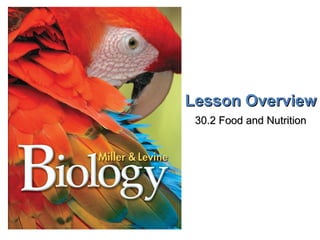Signaler
Partager

Contenu connexe
Tendances
Tendances (20)
Chapter 11 Excretion Lesson 1 - Introduction to Excretion

Chapter 11 Excretion Lesson 1 - Introduction to Excretion
En vedette
En vedette (17)
Similaire à Chapter 30.2
Similaire à Chapter 30.2 (20)
Physical education sports and nutrition class XII-UNIT 2 PPT

Physical education sports and nutrition class XII-UNIT 2 PPT
theimportanceofnutrition-131117094511-phpapp01 (1).pdf

theimportanceofnutrition-131117094511-phpapp01 (1).pdf
FOODS WE EAT - ENVIRONMENTAL STUDIES CLASS III-CBSE

FOODS WE EAT - ENVIRONMENTAL STUDIES CLASS III-CBSE
Chapter 30.2
- 1. Lesson Overview 30.2 Food and Nutrition